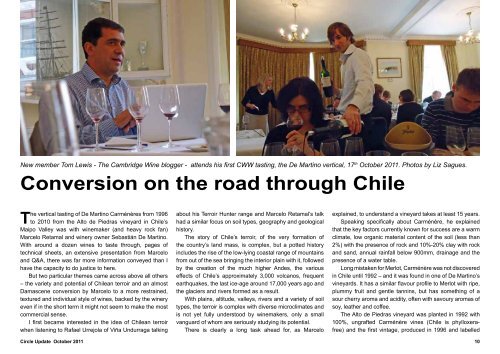You also want an ePaper? Increase the reach of your titles
YUMPU automatically turns print PDFs into web optimized ePapers that Google loves.
New member Tom Lewis - The Cambridge Wine blogger - attends his first CWW tasting, the De Martino vertical, 17 th October 2011. Photos by Liz Sagues.Conversion on the road through ChileThe vertical tasting of De Martino Carménères from 1996to 2010 from the Alto de Piedras vineyard in Chile’sMaipo Valley was with winemaker (and heavy rock fan)Marcelo Retamal and winery owner Sebastián De Martino.With around a dozen wines to taste through, pages oftechnical sheets, an extensive presentation from Marceloand Q&A, there was far more information conveyed than Ihave the capacity to do justice to here.But two particular themes came across above all others– the variety and potential of Chilean terroir and an almostDamascene conversion by Marcelo to a more restrained,textured and individual style of wines, backed by the wineryeven if in the short term it might not seem to make the mostcommercial sense.I first became interested in the idea of Chilean terroirwhen listening to Rafael Urrejola of Viña Undurraga talkingabout his Terroir Hunter range and Marcelo Retamal’s talkhad a similar focus on soil types, geography and geologicalhistory.The story of Chile’s terroir, of the very formation ofthe country’s land mass, is complex, but a potted historyincludes the rise of the low-lying coastal range of mountainsfrom out of the sea bringing the interior plain with it, followedby the creation of the much higher Andes, the variouseffects of Chile’s approximately 3,000 volcanos, frequentearthquakes, the last ice-age around 17,000 years ago andthe glaciers and rivers formed as a result.With plains, altitude, valleys, rivers and a variety of soiltypes, the terroir is complex with diverse microclimates andis not yet fully understood by winemakers, only a smallvanguard of whom are seriously studying its potential.There is clearly a long task ahead for, as Marceloexplained, to understand a vineyard takes at least 15 years.Speaking specifically about Carménère, he explainedthat the key factors currently known for success are a warmclimate, low organic material content of the soil (less than2%) with the presence of rock and 10%-20% clay with rockand sand, annual rainfall below 900mm, drainage and thepresence of a water table.Long mistaken for Merlot, Carménère was not discoveredin Chile until 1992 – and it was found in one of De Martino’svineyards. It has a similar flavour profile to Merlot with ripe,plummy fruit and gentle tannins, but has something of asour cherry aroma and acidity, often with savoury aromas ofsoy, leather and coffee.The Alto de Piedras vineyard was planted in 1992 with100%, ungrafted Carménère vines (Chile is phylloxerafree)and the first vintage, produced in 1996 and labelled<strong>Circle</strong> <strong>Update</strong> October 2011 10


